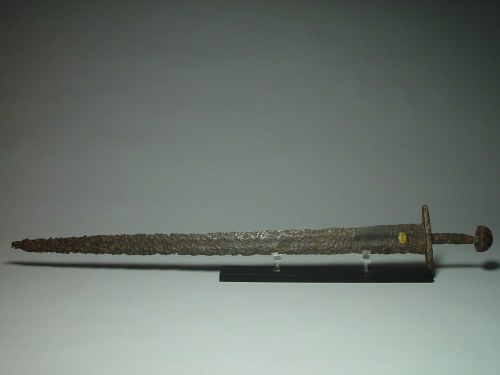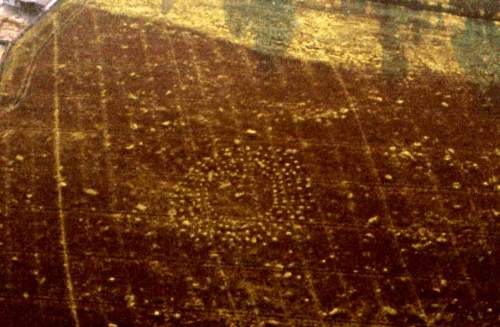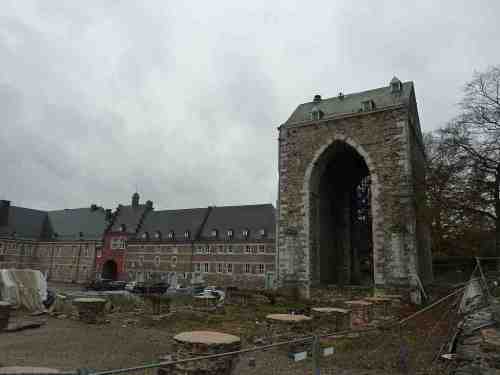The seminar report backlog now reaches this year! And, fittingly, or because I am too ready to say yes to things, the first seminar I attended in 2014 was one that I was giving, before the Centre for the Study of the Middle Ages in Birmingham on 20th January with the title “Miles or militia: war-service and castle-guard in tenth-century Catalonia”. The seminar was only publicised the same day, so I was lucky to get an audience at all, but there were some and I’d like to thank those who came mainly because it was me, since what I do only really crosses the research interests of two people in Birmingham, neither of whom could attend. Anyway: my basic thesis was that there were not many soldiers in tenth-century Catalonia.

I know I over-use this but it is at least more or less contemporary, a depiction of the armies of Israel from the tenth-century Bíblia de Ripoll. I hope, though, that no-one would try using the number of troops an artist can squeeze onto a full-page drawing as indicative of the actual scale of military service in his area…
If you know the field a bit this may strike you as strange.* In the classic feudal transformation argument this was then an area of quite extensive public military service whose use of force is rapidly privatised in the course of the events of 1020-1050. But before that, in 1010 and 1013, the Catalan army’s raiding Córdoba. To which I say, yes, indeed, there are undeniable references to three ‘public expeditions’—but only three, one of those is the 1010 raid and I discovered the third one a few years ago. Other than that it’s the attempt to defend Barcelona in 985, which of course failed. The few references to military action otherwise—and they are very few—are or could be to very small forces, sometimes extremely few like Oliba’s band of pig-rustlers we mentioned here a few posts back. The only reason you’d suppose, if you came to this evidence for the first time, that there was a lot of military action here is because it’s a frontier and there just must have been, or because it’s a Carolingian polity and we know that the Carolingians demanded large-scale military service and we even have legislation exempting people here from it, which is at least negative evidence, or because you just think that early medieval polities fielded large armies. I don’t want to deny any of those things, but the tenth century was not the high Carolingian era here, and the evidence you would want to prove that such things continued (or, in fact, had ever been demanded) here is very thin, and this in an area that is as we know not short of evidence, even if not really for this.

It’s surprisingly hard to find an image of an early medeval sword when you want one, and when you do it’s always a Viking one. This is a late eleventh-century one found near Schleswig. For the Museu d’Art Nacional de Catalunya’s Cataluña Carolíngia exhibition of 1999 they had to borrow one from Paderborn. I don’t mean to try and use that fact as part of the argument but nonetheless I think swords were not common here before 1000.
By way of exploring this further, I then acted like the Anglo-Saxonist I was supposed to be in that rôle and went through wills looking for weapons. Who, if anyone, held the sword in early medieval Catalonia? And the answer seemed to be, again, that while the part of evidentiary silence is always hard to assess, very few people can be shown owning swords, and they were all top-rank castellans or churchmen, these often providing their dependents with weaponry in their wills but not usually swords, of which even they had at most two. Lances and hauberks show up a little bit more often, but not much, and still in the hands of people who also bequeathed quite substantial estates. (Though one of the bishops, Guisad II of Urgell, bequeathed a spata ignea and if anyone has any ideas what that might have been, I’d love to hear them…)

Your humble correspondent, standing in the doorway of the Castell de Tona in 2007. I am not a big man, and that is really not a big ‘castle’.
Lastly I looked at fortifications, because this is after all a country probably named after castellans, and there are certainly a few of those. But, especially if you’re looking for the few that remain from the tenth century, they are firstly not very big, and secondly usually extremely far up sharply pointy hills. If you remember my efforts to climb up to Gurb, you may also remember my wondering how its owners could ever have got horses up there. But if they had, there’d have been hardly any room in which to stable them. And with no horses it would take you two hours or so to reach even the nearest settlement, and far longer the nearest road. Gurb was not placed to control a routeway. I think all of these places were probably more watch-towers and refuges than any kind of offensive base. So where does this all lead us? I give you the conclusion:
This would obviously change. Bonnassie’s picture of an eleventh century busy with cabalarii selling horses and weapons is well-evidenced and helps explain how there could emerge from the sack of Barcelona a polity capable of raiding Córdoba in opposition to Castilian troops and the best armies left to al-Andalus. There is very little evidence of the class of mounted knightly warriors who would make this possible before the year 1000, however; neither is there really any evidence of the relict militarised peasantry supposed to precede it, nor even normative reasons to expect one beyond the 840s. In between these two points we seem, as far as the evidence can carry us, to have a much less militarised society. This in turn implies that the rise of violence and feudalised warfare was indeed sudden and thorough, that the transformation was in this respect real. It was perhaps the new possibilities created by the collapse of the caliphate that made this large-scale militarisation possible, and it may be that by equipping to exploit them the counts gave power to a dynamic they could not, eventually, control. But whether this be so or not, it was not a tenth-century development. Frontier or not, tenth-century Catalonia briefly became a military backwater, or so the evidence and its lack suggest. Military service was possibly still general but extremely occasional, and might often have amounted to no more than a few days’ standing guard on a fighting top high above any potential action. The more normally beweaponed whom we can see seem more like thugs and their bosses, dependants rather than honourable servicemen, but even these are few. This is not what we have been taught to expect from this area and time, but what we have been taught to expect seems not in fact to have very much foundation in the actual surviving evidence, inappropriate though that evidence perhaps be for such questions. The conclusions that can be based on the evidence here, therefore, deserve testing against other areas whence the models that fail here were derived.
* Since this is intended for publication, and even now inches towards submission, I won’t give full references here, but rest assured I do have them and some day soon I hope you can enjoy them…





































